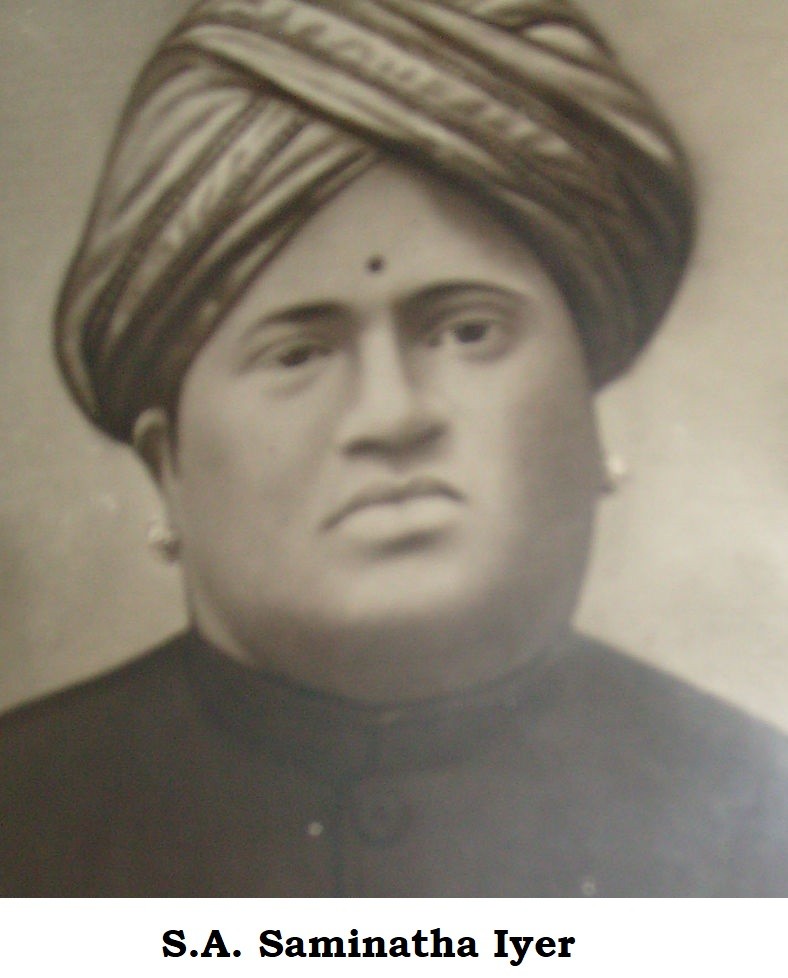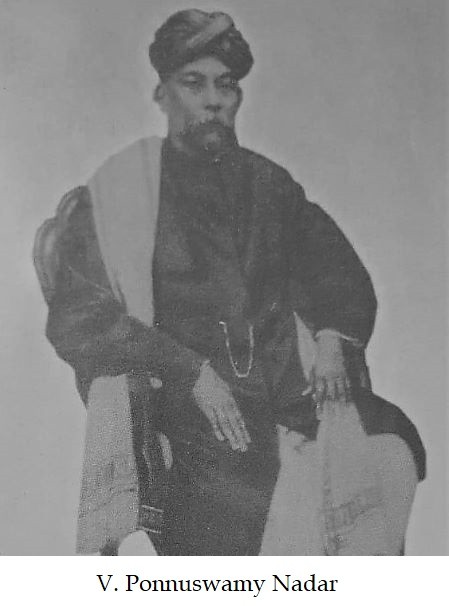By Act XX of 1863, the Madras Government withdrew completely from the administration of the Hindu temples and handed over its rights to Kings or Zamindars if they could prove a hereditary interest in a temple; for maths, a head priest was given virtual private property rights in the entire endowment and where no intermediaries were available, elected committees were formed to carry on the administration.
Fallowing Act XX, the framework of a district arena of politics was created around the temples of Tanjore. Local magnates battled with each other for the resources of the temples and the right to be seen in command of them. This was certainly the beginning of ‘modern’ politics in the district.
When the regulations for the election of members of temple committees came into force, the dominant temple politicians of Tanjore district was Rao Bahadur S. A. Saminatha Iyer (a mirasidar, lawyer and moneylender) and Rao Bahadur T.S. Sivaswami Odayar (landlord). [1]

The rising power of the Porayar Nadar estate, led it to claim a seat on the Kumbakonam temple committee (the committee administered temples of Kumbakonam, Mayavaram and Shiyali [2]). Porayar Nadar estate’s V. Thavsumuthu Nadar’s brother V. Ponnuswami Nadar decided to contest for the committee.
S.A. Saminatha lyer, who was the committee chairman and wanted the place for an ally, ran a campaign which urged the electorate to vote against the Nadars in the interests of preserving caste purity. [3]
The campaign was extremely bitter and violent. [4]
It is noteworthy that, Nadar estate ware moneylenders as well, in Kumbakonam, the clients of the Poraiyar Nadars included Brahman mirasidars, local traders and property owners, policemen, revenue officials and, it was rumoured, even the Tanjore district Collector. [5]

The Nadar estate was supported, of course, not only by his tenants, agents and clients but also by the police and revenue departments, by the Brahman professors at Kumbakonam, who looked to his patronage, and by some of the leading aristocrats of the district, including the V. Appaswami Vandayar, Zamindar of Pundi who could supply him with their dependents. [6]
Meanwhile, Thiruvadathorai Pandarasanidhi (it was the largest Saivite math with large endowments in the districts of Tinnevelly (25,000 acres), Madura (10,000 acres) and Tanjore (3,000 acres) as well as small possessions in others) supported the S. A. Saminatha lyer and to encounter it, the Poraiyar Nadar Estate financed the attempt of his subordinate math at Tirupanandal to break away from him. [7]
The Nadar estate was supported, of course, not only by his tenants, agents and clients but also by the police and revenue departments, by the Brahman professors at Kumbakonam, who looked to his patronage, and by some of the leading aristocrats of the district, including the V. Appaswami Vandayar, Zamindar of Pundi who could supply him with their dependents. [6]
The Nadar estate had contacts already inside the temple committee, who put some of its resources at his disposal, and other voters who were not tied to him and his friends by pre-existing links of patronage and welfare were bought for silver rupees at the polling booth. A whole cross-section of society worked together in his interest, held together by a variety of strands which led to him personally.
In spite of S. A. Saminatha lyer’s campaign and the fact that the entire electorate was composed of caste Hindus, the Porayar Nadar estate won by an overwhelming majority. [8]

Nadar estate’s V. Ponnusami Nadar (Vellaiya Nadar’s 2nd son) was appointed as a member of the Devastanam Committee controlling the temple at Kumbakonam in 1889, any controversy there might have been about his caste died down. [9]
Ponnusami Nadar was the first from the Nadar community in to get into a temple committee. As a committee member, his authority was accepted as the equal of any other.
At Kumbakonam, in the heartland of the Tamil Brahman, the committee was dominated and run mostly by members of the other castes., i.e. T. Ponnuswami Nadar, V. Appaswami Vandayar and T. S. Sivaswami Odayar and very few Brahmans could get onto it. [10]
This spectacle of a Nadar on the temple committee in orthodox Thanjavur created a stir in the 1890s.
But within the next thirty years, it had become the custom that member of Porayar Nadar estate, was allowed to sit on the Temple Committee as a mark their (temple’s) status. [11]
Earlier in Thavsumuthu Nadar’s period, Porayar Nadar estate has met the costs of various ceremonies and festival expenses and had established various Kattalais (endowment for certain specific religious services in a temple) on the temples by donating lands and depositing money with the temples. The temples include Nataraja temple in Chidambaram*, Thiruchendur Murugan temple, Kumbeswarar temple in Kumbakonam, Palzhi Murugar temple and Abirami temple in Thirukkadaiyur.
*During the Kumudi case, the Nadars of Sivakasi, called upon the priest from Chidambaram temple to court as a witness and testified the Poraiyar Nadar estate’s privileges in the temple as the proof that the Nadar community is not of low station and requested the Judge to allow them (Sivakasi Nadars) also to the Kumdi temple. [12]
Since the period of Vellaiya Nadar, the family of Nadar estate is the hereditary trustee of 5 temples in Porayar: 1) Shivan temple 2) Vishnu temple 3) Kumaran temple 4) Vinayakar temple 5) Ayyanar temple. Nadar estate family has donated more than 350 acres of agricultural land for these temples.
Zamindar Thavsumuth Nadar built a temple for Goddess Parvati in Poraiyar in the 1880s and his brother Ponnuswamy Nadar built a temple for Lord Vinayakar in Kumbakonam.
References
[2] Hindu and Christian in South-east India: Aspects of Religious Continuity and Change, 1800–1900 by Geoffrey A. Oddie.
[3] Page 29, South India Political Institutions and Political Change 1880–1940 by C. J. Baker, D. A. Washbrook
[4] Hindu 23 July, 6, 15, 22, 24 and 27 August 1888.
[5] Hindu 7 March 1888, 10 and 17 June 1896 | Page 106, The Emergence of Provincial Politics – The Madras Presidency 1870—1920 By D. A. Washbrook
[6] Page 29, South India Political Institutions and Political Change 1880–1940 by C. J. Baker, D. A. Washbrook
[7] Page 38, South India Political Institutions and Political Change 1880–1940 by C. J. Baker, D. A. Washbrook | Hindu 23 July, 22, 24 and 27 August 1888.
[8] Page 187, The Emergence of Provincial Politics – The Madras Presidency 1870—1920 By D. A. Washbrook | Hindu and Christian in South-east India: Aspects of Religious Continuity and Change, 1800–1900 by Geoffrey A. Oddie.
[9] Page 29, South India Political Institutions and Political Change 1880–1940 by C. J. Baker, D. A. Washbrook
[10] Page 188, The Emergence of Provincial Politics – The Madras Presidency 1870—1920 By D. A. Washbrook
[11] The Hindu, 6 and 15 August 1888, 30 October 1894 | Also G.O. No. 1112, LSG, 9 March 1928 | Page 73, South India Political Institutions and Political Change 1880–1940 by C. J. Baker, D. A. Washbrook
[12] Page 124, The Nadars of Tamilnad By Robert L. Hardgrave
Comment 1
April 19, 2023 at 5:00 pm
சாந்தார நாழி
தமிழ்நாட்டிலும் கேரளாவிலும் வில்லவர் குலங்கள் ஆட்சி செய்தபோது, சைவக் கோயில்களின் கருவறையைச் சுற்றி சாந்தார நாழி அல்லது சாந்தார நாழிகை என்று அழைக்கப்படும் ஒரு பாதை இருந்தது, அதன் மூலம் சான்றார் மன்னர்கள் கர்பக்ரிஹத்தை சுற்றி வந்தனர்.
சான்றார்கள் சேர, சோழ, பாண்டிய நாடுகளை ஆண்ட வில்லவர் உயர்குடியினர் ஆவர். சாந்தார நாழி என்று அழைக்கப்படும் இந்த அரச பாதை சுமார் ஏழு முதல் பத்து அடி அகலம் கொண்டது மேலும் இது கருவறையைச் சுற்றியுள்ள உள் சுவருக்கும் கோயிலின் வெளிப்புறச் சுவருக்கும் இடையில் அமைந்திருந்தது. இந்த பாதை கோவிலின் மேற்கூரையின் கீழும், கோவிலின் கோபுரத்தின் கீழும் இருந்ததால், புயல் மற்றும் கனமழையில் இருந்து பாதுகாக்கப்பட்டது. கடுமையான வானிலை நிலைகளிலும் கூட வில்லவர் வம்சங்களின் சான்றார் மன்னர்கள் அதாவது சேர, சோழ பாண்டிய மன்னர்கள் தங்களின் அரச வழித்தடத்தில் கருவறையில் உள்ள தெய்வத்தை சுற்றி வரலாம்.
சாந்தாரா நாழியின் சுவர்கள் அற்புதமான ஓவியங்களால் அலங்கரிக்கப்பட்டிருந்தன. இந்த சோழர் கால ஓவியங்கள் பல நாயக்கர் காலத்தில் பூசப்பட்டு புதிய ஓவியங்கள் வரையப்பட்டபோது அழிக்கப்பட்டன.
தஞ்சாவூர் பெரிய கோயில் என்றழைக்கப்படும் பிரகதீஸ்வரர் கோயிலில், சாந்தார நாழியில் இருந்த சோழர் கால ஓவியங்கள் பிற்கால நாயக்கர் கால ஓவியங்களால் மறைக்கப்பட்டன. சமீபத்தில் இந்த சோழர்கால ஓவியங்களில் சில மீட்டெடுக்கப்பட்டுள்ளன.
சாந்தார நாழியின் சுவர்களில் சிவபெருமானின் 108 நிலைகள் புடைப்புச் சிற்பங்களாக பொறிக்கப்பட்டுள்ளன. தஞ்சைப் பெரியகோயில் சாந்தார நாழி இரண்டு தளங்களைக் கொண்டுள்ளது.
சான்றார் பட்டத்தின் மாறுபாடுகள்
சான்றார், சான்றோர், சான்றாரா, சாந்தார், சாந்தகர், சானார், சாணார், சாண்டார், சாந்து பாலன், சாந்தவர், சார்ந்தவர் போன்றவை வில்லவர்களின் சான்றார் பட்டத்தின் சில வேறுபாடுகளாகும்.
வில்லவர், வானவர், மலையர் போன்ற பல்வேறு வில்லவர் துணைக்குழுக்கள் மற்றும் தொடர்புடைய மீனவர் குலங்கள் ஒன்றிணைந்தபோது சான்றார் மற்றும் நாடாள்வார் என்ற நாடார் குலங்கள் தோன்றின.
சாந்தகன்
கி.பி 16 ஆம் நூற்றாண்டில் எழுதப்பட்ட திருவிளையாடல் புராணத்தில் பரஞ்சோதி முனிவரால் சேர மற்றும் சோழ மன்னர்கள் சாந்தகன் குலத்தைச் சேர்ந்தவர்கள் என்று விவரிக்கப்பட்டுள்ளது.
சாந்தகன் பட்டம் நாடார்களின் சான்றார் பட்டத்தின் மாறுபாடாகும்.
"ஆற்றல் மிகு பிரதப சூரியன் வங்கிசத்துவன் அளவு இல் சீர்த்தி
சாற்ற அரிய இரிபும மருத்தனன் சோழ வங்கி சாந்தகன்
தான் வென்றி
மாற்ற அரிய புகழ்ச் சேர வங்கி சாந்தகன் பாண்டி வங்கி
கேசன்
தோற்றம் உறு பரித்தேர் வங்கிச் சிரோமணி பாண்டீச் சுரன்தான் மன்னோ".
சான்றாரா பாண்டியன் வம்சம்
கர்கலா-பாண்டியநகரியைத் தலைநகராகக் கொண்டு ஆண்ட கர்நாடகாவின் சான்றார பாண்டிய வம்ச மன்னர்கள் தங்களை சான்றாரா பாண்டியர்கள் என்று அழைத்துக் கொண்டனர். சில கல்வெட்டுகளில் சான்றாரா பாண்டியர்கள் சாந்தார பாண்டியர், ஸாந்தா, சான்றா, சாந்தா, சாந்தாரா மற்றும் ஸான்றா என்றும் குறிப்பிடப்பட்டுள்ளனர்.
சாந்தாரம் என்பது கோயிலின் கருவறையைச் சுற்றிலும் கோயிலின் வெளிப்புறச் சுவருக்கும் கருவறைச் சுவருக்கும் இடையே உள்ள வட்டப் பாதையாகும்.
சேர, சோழ, பாண்டிய வம்சங்களின் வில்லவர்-சாந்தார் மன்னர்கள் மற்றும் அரச குடும்பங்கள் "சாந்தார நாழி" மூலம் கருவறையை சடங்கு முறையில் சுற்றி வந்தனர். சாந்தார நாழி கோயிலின் கூரையின் கீழ் இருந்ததால், சாந்தார் மன்னர்கள் கடுமையான வானிலையிலும் வழிபடவும், சுற்றி வரவும் முடிந்தது.
வில்லவர்களால் ஆளப்பட்ட தமிழ்நாட்டிலும், ஹம்பியில் பாண வம்சத்தினர் என்று அழைக்கப்படும் வில்லவர்களின் வடக்கு உறவினர்களால் கட்டப்பட்ட கோயில்களிலும், பாண பலிஜா-ஐநூற்றுவர் ஆட்சி செய்த ஐஹோளேயிலும், சான்றாரா பாண்டியன் வம்சத்தால் ஆளப்பட்ட கர்காலாவிலும் சாந்தார நாழி கொண்ட கோயில்கள் தோன்றின.
16 ஆம் நூற்றாண்டிற்குப் பிறகு, சான்றார்கள் சாந்தாரநாழி வழியாக தெய்வத்தை வலம் வரும் பாக்கியத்தை இழந்தது மட்டுமல்லாமல், சான்றார்கள் தங்கள் மூதாதையர்களின் கோவில்களுக்குள் நுழைய அனுமதி மறுக்கப்பட்டனர்.